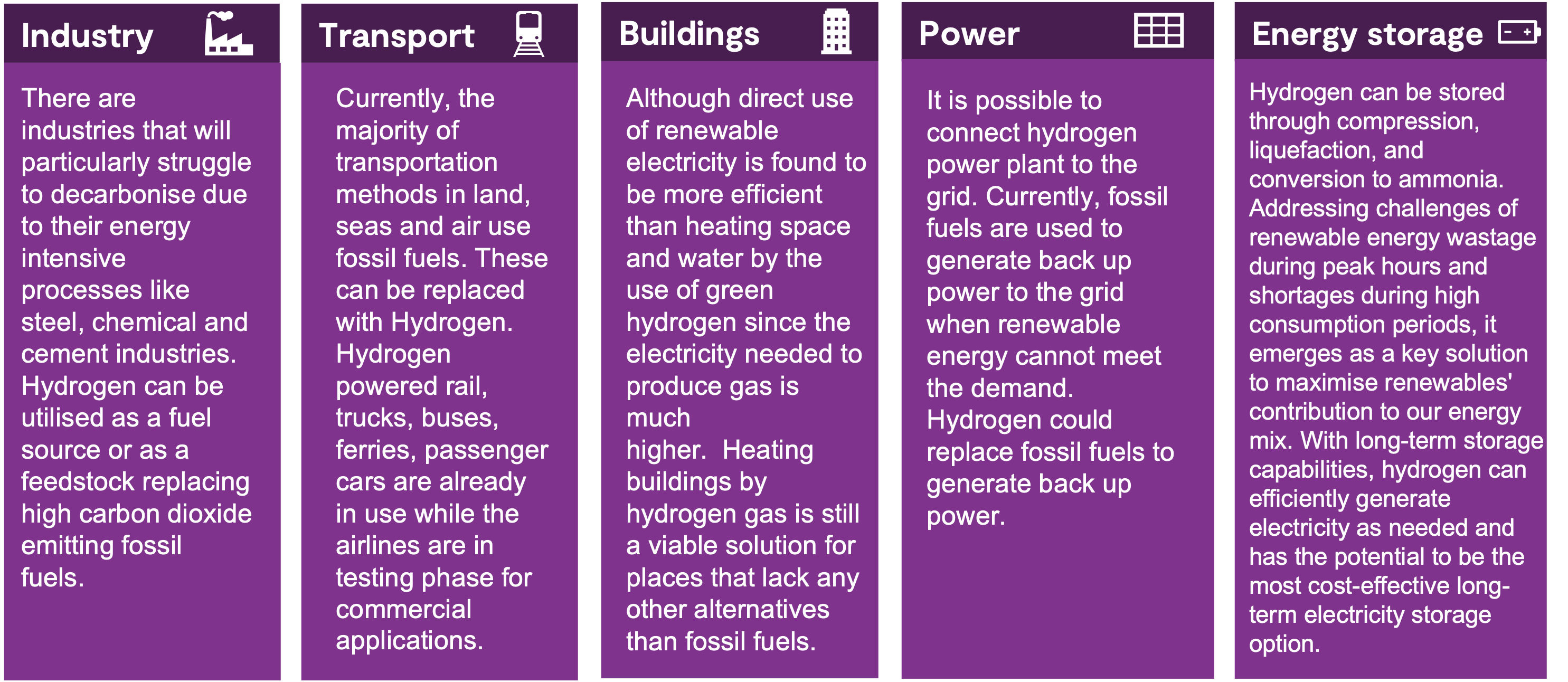Green Hydrogen: A key Piece of the Puzzle for Net-Zero in the UK
Green hydrogen has the potential to transform the energy landscape, and many countries, including the UK, are actively exploring its role as a key component in achieving their decarbonisation objectives.
As countries strive towards net-zero emissions to reduce the harmful effects of greenhouse gases and pollution, the search for clean and sustainable energy has become a top priority. A promising solution that has emerged in recent years is green hydrogen – a fuel that is produced using renewable energy sources and emits no greenhouse gases when burned. For this article, our data insights and visualisation specialist has teamed up with our hydrogen sector expert to explore the various applications of green hydrogen and provide a data-driven overview of its state in the UK.
Innovate UK KTN, as a part of the UK’s innovation agency, is working to accelerate the uptake of clean hydrogen through the Hydrogen Innovation Network – a cross-sector network focused on addressing the gaps in the hydrogen economy to enable sustainable clean energy transition. This is the first of a series of collaborations the KTN Futures team will be undertaking to provide you with insights into different sectors and the broader UK innovation ecosystem.
One size doesn’t fit all for hydrogen
A versatile energy carrier, hydrogen is gaining momentum as a promising alternative to fossil fuels. While hydrogen is the most abundant element in the universe, producing it here on Earth can be challenging. As a result, different types of hydrogen have been developed and classified into different colours tinted by production methods and their environmental effect. Ranging from grey to green, this colour palette of hydrogen offers a glimpse into the various energy production methods available. (You can also hear about these in our podcast episode “The Colours Of Hydrogen”.)

At present, the primary method of hydrogen production involves extracting it from fossil fuels, mainly methane (natural gas) since it can be produced on a large scale whereas green hydrogen production has not scaled up to meet the demand. However, renewable energy sources, such as geothermal, solar, and wind power, are being increasingly utilised to produce hydrogen. And as newer technologies emerge, alternative production methods that rely more heavily on renewables could become more economically viable in the future. In fact, green hydrogen is expected to become a crucial part of the world’s energy mix according to the International Energy Agency’s (IEA) net zero emissions scenario.
Your browser may be blocking third party cookies, to view embeded content you will need to allow third party cookies.
As highlighted above, the IEA predicts that the worldwide demand for hydrogen will surpass 500 million metric tons by 2050 – a close to sixfold increase. To meet decarbonisation objectives outlined in their Net Zero Emissions scenario, it is projected that green hydrogen production will replace grey hydrogen gradually and constitute 30% and 60% of overall hydrogen production by 2030 and 2050 respectively.
As global hydrogen consumption is expected to surge, it is imperative to identify the areas that can benefit the most from the use of green hydrogen. As its vast potential extends to numerous sectors including industry, transport, buildings, power and as an energy storage medium, a comprehensive understanding of the various applications of this adaptable fuel is essential to accelerate the sustainable transition to a low-carbon economy and achieve our climate targets.

How does this apply to the UK? What does the UK landscape look like?
Hydrogen projects in the UK have been expanding, as depicted in our map of projects published by the Department for Energy Security and Net Zero.
Your browser may be blocking third party cookies, to view embeded content you will need to allow third party cookies.
In fact, the UK Government has launched several significant hydrogen research and development projects and programmes in recent years, such as the £1 billion Net Zero Innovation Portfolio, £240 million Net Zero Hydrogen Fund and £4.5 million UKRI Hydrogen storage and distribution supply chain R&D competition. Please beware that public support programmes for hydrogen are also likely to be published without the word ‘hydrogen’ in them such as the Industrial Energy Transformation Fund, Zero Emissions Road Freight trial, Ofgem Strategic Innovation Fund, DfT Clean Maritime, Decarbonising Heating and Cooling.
In terms of the production methods fuelling these use cases, currently, the vast majority of hydrogen produced in the UK relies on fossil fuels. However, green hydrogen is gaining traction among players in the oil and gas, utilities, and industrial sectors, who are eager to establish themselves as early movers in this new industry and pursue their decarbonisation and portfolio diversification strategies. In fact, green hydrogen projects with a total potential capacity of about 5.7 GW have already been announced, making up half of the government’s 10 GW electrolyser-based hydrogen capacity target by 2030.
The North Sea and Celtic Sea have set ambitious goals for offshore wind projects, aiming to generate over 4 GW of renewable energy capacity. These plans offer promising opportunities for producing low-carbon green hydrogen using Dolphyn technology. This innovative approach utilises floating offshore wind power to generate low-carbon green hydrogen, which will then be transported ashore through a dedicated pipeline. Another noteworthy project is BP’s HyGreen Teesside, which also aims to harness renewable energy sourced from offshore wind projects. Together with the blue hydrogen H2Teeside project in the same valley, HyGreen Teesside reinforces Teesside’s position as one of the UK’s top hydrogen hubs for decarbonising industry and heavy transport, with both projects possibly contributing to 15% of the UK’s 2030 hydrogen production target. Through this Innovate UK funded project, BP is partnering with UK government, local industry, and authorities such as the Tees Valley Combined Authority (TVCA) to accelerate transport decarbonisation.
These initiatives are just a few examples that demonstrate the growing presence of green hydrogen in the UK and help highlight the country’s significant advantages in this field.
What are the synergies between green hydrogen and the UK?
1. The United Kingdom has an abundant supply of renewable energy from wind, solar, and tidal sources that can serve as a reliable and sustainable source for generating green hydrogen.
The UK possesses significant potential for abundant wind energy resources both onshore and offshore. Emission-free green hydrogen can be produced offshore and transported onshore to be applied for various uses, or the power generated from wind energy can be transmitted to the shore for hydrogen production. The possibility of hydrogen exportation also exists, but it is crucial to note that the projected demand within the UK suggests that all produced hydrogen will be necessary to meet domestic needs.
Until 2021, the country held the record for the largest installed offshore wind capacity worldwide, with over 20% global offshore wind operating capacity installed. The graph below illustrates the growth of the UK’s considerable wind power capacity. To see where onshore and offshore wind in the UK is located, visit the UK Renewable Energy Capacity Dashboard.
Your browser may be blocking third party cookies, to view embeded content you will need to allow third party cookies.
2. Another key factor in the UK’s pursuit of green hydrogen is its existing industrial clusters, which include the Humber, Teesside, Merseyside, South Wales, Southampton and Grangemouth.
These areas have a high concentration of energy-intensive industries such as steel, chemicals, and cement production, and are responsible for a significant proportion of the UK’s greenhouse gas emissions.
The interactive map below outlines in more detail the UK industrial clusters’ activity and related emissions arising from the combustion of gas and oil to produce heat in these industries – with the largest emitting activity being refining, closely followed by iron and steel and chemicals as the third largest emitting activity.
In line with industrial clusters’ emitting activities, the UK’s top hydrogen consumers currently include refineries (52%), ammonia producers (29%), and chemical manufacturers (10%). Together, these industries make up the majority of hydrogen consumption at 92%, while other sectors such as energy, transportation, and laboratories account for the remaining 8%. It is important to note that hydrogen is currently predominantly utilised as a feedstock in industrial processes rather than as a direct fuel for heat generation. Therefore, the sectors mentioned have even further potential to increase their hydrogen consumption, as transitioning from fossil fuels to hydrogen for heat generation would have a substantial impact on reducing emissions.
3. In addition, the UK is in a strong position to benefit from the cost-effective green hydrogen market, thanks to its advanced supply chain.
According to a recent study conducted by Wood and Optimat, commissioned by BEIS, the UK’s hydrogen equipment supply chain has the potential to make a substantial economic contribution. The study projects a Gross Value Added (GVA) of nearly £1 billion by 2030 and up to £3 billion by 2050. This growth is anticipated to support approximately 27,500 jobs by 2050, with export opportunities reaching £2.2 billion by 2030 and further expansion in the future. The report highlights the UK’s strengths in the green hydrogen value chain and market, pointing out key advantages. The diverse selection of UK manufacturers and suppliers, drawing from their experience in industries such as oil & gas, oil refining, petrochemicals, and power, positions them well to contribute to the growth of the green hydrogen market. This expertise translates to a significant opportunity for UK manufacturers to export their goods and services to the global market.
4. Collaboration is key
As demonstrated by the projects mentioned, public and private actors in the UK are collaborating to accelerate the uptake of clean hydrogen and tackle technical and economic challenges.
With collaboration at its core, Innovate UK KTN takes an active part in this endeavour. In the realm of hydrogen, we have several projects of potential interest which are aimed at advancing and integrating the supply chain, fostering innovation and driving progress in this crucial field.
Innovate UK KTN’s Hydrogen Innovation Network is a truly cross-sector cross-team network that is working to enable low-cost clean Hydrogen uptake at scale and cost. It has applied various ways to bring different sectors involved in the hydrogen supply chain together to foster collaboration, innovation and ramp up hydrogen supply chain. The network also plans to solve Hydrogen based challenges to the organisations in the supply chain via Innovation Exchange programmes.
Our team is also facilitating knowledge transfer and introductions through its Hydrogen Supply Chain Directory, which shares the details of those who are currently producing, storing, transporting, and using hydrogen. It also showcases solutions-providers who may be able to help these end users meet their hydrogen targets.
Please also feel free to reach out to the article’s authors directly (see below) with any thoughts, questions, or enquiries.
Related programme

Hydrogen Supply Chain Directory
This directory shares the details of those who are currently producing, storing, transporting, and using hydrogen. It also showcases solutions-providers who may be able to help these end users meet their hydrogen targets. Innovate UK KTN can facilitate knowledge transfer and introductions for users of the directory.


